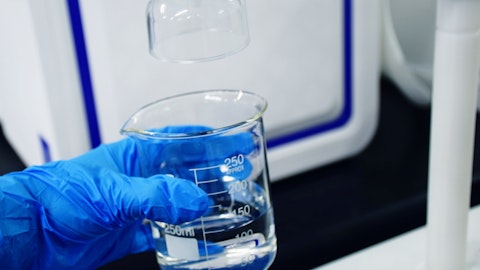Mitchell Steiner: Yes, so, part of the reason we’re doing the Phase 2b the way we’re doing it is to get some questions answered to address that question. So, for example, the first part, which is the primary study is, in combination with a GLP-1. how does Enobosarm work? Can we maintain muscle? How much additional fat do we lose? And so, that gives you that information, and of course, physical function, seeing how we can prevent the decline of physical function and that. Second part, the open label study is kind of addressing the question you’re asking, and that is, if you stop the GLP-1 for the patient that did not take Enobosarm in combination and they’ve lost muscle, and the fear is if you stop the GLP-1, you get the rebound weight gain, which is almost all fat, that you’ve actually made them worse because now they have less muscle and they have the same weight, but it’s all fat and weaker.
And so, it would be nice to see what the effect of Enobosarm is in that situation to rescue and prevent the rebound weight gain, fat gain. And those pieces of information will allow us to think more globally at a higher level like you’re thinking, and that is, how would you use it? So, here’s some examples. One, could Enobosarm, which by itself has a direct effect of reducing fat and maintaining muscle in combination with a GLP-1 receptor agonist, be used in combination? So, you can use less of a GLP-1 receptor agonist. As you know, GLP-1 receptor agonists have GI toxicity. And that’s the reason why people have all kinds of gastrointestinal pain, nausea, vomiting, diarrhea and bloating and that kind of stuff. And we can decrease some of those with an agent like Enobosarm that doesn’t have any of that.
Then you could have a situation where the combination of a GLP-1 with Enobosarm, you can have less of the GLP-1, potentially. The other way to think of it is the biggest problem that is occurring now is everybody got onto GLP-1s and they’re recognizing they hit this plateau. And the plateau, as I mentioned in my former comments, is because particularly in the sarcopenic obese patient or an elderly patient where they have very little muscle reserve, happens because when muscle goes down to a critically low level, it kicks off the appetite mechanism. Appetite mechanism is pretty powerful. It won’t let you die. And so, that happens, then you basically have a push me, pull you with the GLP-1 that’s making you lose weight while the appetite’s asking you to put the weight back on all because the muscle has triggered that.
If you maintain muscle, then the question is, could you have a deeper fat loss? If you have a deeper fat loss, then again, the combination of our drug plus GLP-1 would be a higher quality, but better from the point of view that you mention, and that is, what is the target weight loss that you want? So, if you want a target weight loss that’s beyond what your muscle will allow, again if you do the 50-50 rule, for every pound of fat you lose, you lose a pound of muscle. That’s a lot to pay for, but you don’t have to make that payment and you can lose a lot more of the fat, then you can have a better success in getting to your target weight potentially. And so, that could be very interesting in getting rid of the plateau. And so, again, I would see Enobosarm in combination with GLP-1, will allow you to manipulate the GLP-1 to reduce dose potentially and to potentially get to your target weight without hitting the plateau.
Now, what happens if you want to stop? The chronicity of GLP-1, do you take it for the rest of your life? And some people wanted to get off of it because of side effects. So, if you could have a drug like Enobosarm that could be given almost like you’re cycling. So, you stop the GLP-1, keep the Enobosarm going, then you maintain muscle, and Enobosarm has direct effects on fat. So, decrease the potential for the rebound of fat, and then bring back the GLP-1 if you want to get back to your target weight again and keep avoiding that accelerated rebound and just have a more gentler weight loss. And that’s – when I say high quality, high quality means weight loss where your muscle and fat body composition is such that the appetite mechanism that gets you into trouble.
So, summary, I see this being used in combination with a GLP-1 chronically, potentially changing the GLP-1 dose, potentially using the drug to help you decide how you want to stop the GLP-1 and add it back in. And then furthermore, for those patients that got into trouble that did not start with Enobosarm and took a GLP-1 and want to discontinue the drug, then they have an opportunity to build their muscle back if they lost significant muscle, or to potentially stop the fat rebound weight regain. So, it’s a lot of information there, but I think the Phase 2b, again, it’s not meant to be the Phase 3 study where you say, okay, I’m going to look at weight loss at 48 weeks, and am I 5% greater than the weight loss of the control arm? No, this is asking the very critical questions of how ultimately do we want to use Enobosarm?
And the very high level, the two areas are with a GLP-1 and second area is to rescue somebody on a GLP-1.
Leland Gershell: Got it. Thanks for the added information.
Operator: [Operator instructions]. Our next question comes from Yi Chen with H.C. Wainwright. Please go ahead.
Yi Chen: Thank you for taking the questions. Just to clarify, because Enobosarm has the ability to preserve muscle mass, that in the Phase 2b trial, it is possible that within the first 16 weeks of Enobosarm plus GLP-1 drug combo versus GLP-1 drug alone, that for the combo arm, we could see patients lose less total weight versus GLP-1 drug alone arm. Is that right?
Mitchell Steiner: No, I don’t think so. I think what you’re going to see in this situation is what’s missing in your characterization of Enobosarm is Enobosarm does two things. One, it preserves muscle, and two, it also augments the fat loss. So, GLP-1 receptor agonist by itself is muscle and fat. And so, if we have a situation where you maintain the muscle – again, we’re not trying to make Arnold Schwarzeneggers. We’re not trying to pick a dose that you put so much muscle on that that has to counteract the amount of fat that you’ve lost. Part of it is can you dial down the muscle part so that you maintain muscle, but you make it up by reducing the fat even more than a GLP-1 by itself. That’s the idea. If it didn’t have direct effects on fat, I would say, okay, I don’t know what’s going to happen, but it has direct effects on fat.
And so, it could be possible the higher dose of Enobosarm, I mean, you have the same muscle, similar muscle maintained, but you have a greater fat loss. So, we’re going to learn that in the Phase 2b at 16 weeks. And so, again, the key thing here is, can we maintain the muscle, get a deeper fat loss, and the Semaglutide is going to take muscle and fat equally. By 16 weeks or so, it’s starting to hit the plateau.
Yi Chen: Would it be meaningful to have an arm receiving Enobosarm alone in this trial?
Mitchell Steiner: So, we’ve thought about that because Enobosarm alone would be very, very interesting. But we have again, not in obese patients, but we have in patients that are normal postmenopausal elderly patients. So, we have – we know a lot about Enobosarm in that setting as monotherapy. And we do have data from a 504 study in a subset of patients that were obese in the lung cancer study that pretty much falls in line with what I just said. And that is what we saw in that study where the cancer causes basically a starvation state, that we saw we were able to maintain muscle. Muscle was about 0.3 kilos where the GLP-1 lost about, I guess in that study, about three kilos or something of that sort. And we looked at total weight at 21 weeks.
There was much greater weight loss in the Enobosarm arm than the placebo arm in that patient population. What we saw, the weight loss was due to the fat loss because you maintain the muscle. So, we do have data like that. I think for purposes of this study here, we’re not trying to make Enobosarm by itself the weight loss drug. I think where we need to get clarity, and again, no company out there at this point now has clinical data in combination with GLP-1 with their drugs, is to get that information because that’s more important, understanding what is the magnitude of the hypocaloric influence and what is the dose we need to counter that? And then that’ll allow us to ask additional questions later.
Yi Chen: Got it. You mentioned that in a future Phase 3 trial, the endpoint could be measured at 48 weeks. Is that correct? And I also wonder, how many patients could be required for a future Phase 3 trial and whether Veru plans to conduct a trial by itself or potentially with a partner? Thank you.
Mitchell Steiner: Yes, so the answer is we’re absolutely seeking a partner, but the way we’re designing this study is, the way we’re thinking about it is, we have a Phase 3 that is potentially an all-comers study, in which case weight loss is your endpoint. And the weight loss endpoint, all you have to show is 5% incremental increase, which means that would be again, the standard endpoint of 48 weeks. The FDA wants it to be at least a year. However, embedded in that study of the patients that are in our Phase 2b, greater than 60 years of age. And the reason we picked that patient population is because physical function and potentially lean body mass could be interesting endpoints in itself. So, depending on how our discussions go with the FDA, do we focus on a subpopulation of which the clinical benefit risk ratio is different and the endpoints are going to be different potentially, or do you go after a weight loss population, and in which case you’re not worried about muscle, just get the muscle function, because that’ll be something that you can put in your label, and I think that will be important.
But get the endpoint of 5% better decrease in weight at week 48 and you get it. Gary, do you want to add to that?
Dr.Gary Barnette: No, I think that the outcome of this study that we’re running will dictate that, will dictate where we go and how big that study will be, what the primary endpoint will be, whether the FDA is just purely looking at weight loss, or whether they’re looking at weight loss, as Mitch mentions, with a component of body composition. Increasing or maintenance of lean mass and increasing fat reduction would be, in my opinion, a very positive outcome for these patients. And that quality, what I’m going to term is quality weight loss, would be very important for overall health benefit.




